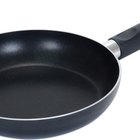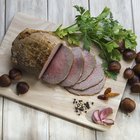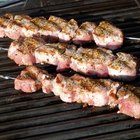bernjuer/iStock/GettyImages
Cuts from a steer's shoulder, better known as the chuck, are well known for their combination of flavor and toughness. This makes shoulder cuts a fine candidate for slow-cooking, which brings out their rich beefiness while reducing their tough, leathery muscles to silky softness. A seven bone roast -- named for the bone's resemblance to the numeral seven, not because it contains seven bones -- makes an excellent pot roast. It can be cooked in a countertop slow-cooker, but your oven works just as well.
Pat the roast dry with clean paper towels. Wipe the cut ends of the bone to remove any fragments or debris left behind by the butcher's meat saw.
Heat a heavy Dutch oven or roasting pan over a medium-high burner. When the pan is hot, pour in a tablespoon of oil and press the roast into the pan. Sear it on all sides until it's deeply browned, then remove the pan from the burner.
Lift the roast from the pan to a plate and season it liberally with salt and pepper, or any other spices and flavorings you prefer. Chop onions, celery and carrots and place them in the bottom of your pan, to make a platform for the pot roast. Position the beef on top of the vegetables.
Pour in enough water, beef broth, red wine or other cooking liquids to come at least 1/3 of the way up the sides of the roast, or up to halfway. Cover the pan with its lid, or with heavy-duty aluminum foil.
Place the roast in a preheated oven at 325 degrees Fahrenheit. Slow-cook it for 2 to 4 hours, depending on its size, or until it's fork-tender when tested. If you want to cook vegetables with the roast for an easy one-pot meal, add them after the first hour of cooking time.
Remove the roast from the oven when it's done, and transfer it to a serving tray. Cover it loosely with foil, and let it rest for at least 15 to 20 minutes before carving. If you've cooked vegetables with the roast, remove them with a slotted spoon and keep them warm. Strain the cooking liquid and thicken it, to make a sauce or gravy. Serve the meat, vegetables and sauce together or separately at the table.
Related Articles
How to Cook a Lamb Square Cut Shoulder

How to Cook a Deer Neck Roast in a Slow ...

How to Use an Electric Roaster to Slow ...

How to Use a Roaster Oven to Cook a ...
How to Cook Tender Peeled Knuckle

How to Cook Beef Top Round Pot Roast

How to Grill a Semi-Boneless Leg of Lamb

How to Cook a Tender Eye Roast

How to Make a Blackbuck Antelope Roast
How to Cook a Standing Rib Roast on a ...
How to Cook Buffalo Fillet

How to Cook Silverside on a Stove Top

How to Prepare Chuck Tender Roast
How to Slow Cook a Pot Roast With Beef ...
How to Cook a Beef Hind Shank in a Slow ...

How to Cook a 15-Pound Rib Roast

How to Cook Venison With Tomatoes in a ...

How to Cook Pork Loin

How to Cook a Beef Topside Roast

How to Cook a Tender Top Sirloin Roast
References
- Beef -- It's What's For Dinner: 7-Bone Chuck Roast
- Professional Cooking; Wayne Gisslen
Resources
Tips
- The browning step is optional, but adds noticeably to the flavor of your pot roast. If you don't have a Dutch oven or a roasting pan that's suitable for stovetop use, brown the beef in a heavy skillet and then transfer it to your roasting pan.
- If your pot roast is fully cooked to the fork-tender stage, you should be able to pull the central bone out of the roast while it's resting. Use the tip of a knife to free the meat from the bone, if necessary. This makes it easier to slice the pot roast.
Writer Bio
Fred Decker is a trained chef and prolific freelance writer. In previous careers, he sold insurance and mutual funds, and was a longtime retailer. He was educated at Memorial University of Newfoundland and the Northern Alberta Institute of Technology. His articles have appeared on numerous home and garden sites including GoneOutdoors, TheNest and eHow.